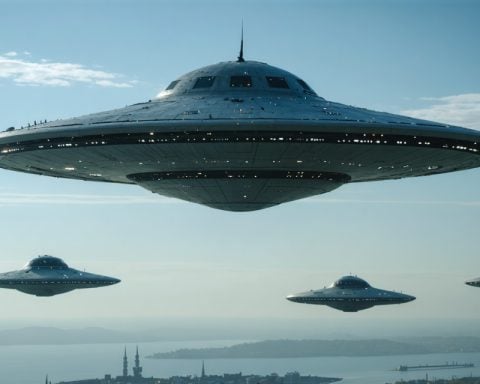- AI and machine learning are revolutionizing UFO documentaries, offering new ways to explore and analyze extraterrestrial phenomena.
- AI-driven analytics improve traditional methods by enhancing video footage and cross-examining astronomical data.
- AI is used to analyze declassified documents, revealing potential extraterrestrial activity through identified correlations and anomalies.
- Virtual reality (VR) and augmented reality (AR) create immersive experiences, allowing deeper audience engagement with UFO content.
- The evolving technology promises more credible and scientifically-backed claims in UFO research and documentation.
- UFO documentaries are becoming more educational and insightful, advancing our understanding of potential extraterrestrial life.
In an age where artificial intelligence and machine learning are reshaping various industries, the realm of UFO documentaries is witnessing a groundbreaking shift. The integration of cutting-edge AI technology has opened up new dimensions in the search for extraterrestrial life, offering a fresh perspective on age-old mysteries.
Traditionally, UFO documentaries relied heavily on eyewitness testimonies, grainy footage, and expert interviews. However, the narrative is evolving with the introduction of AI-driven analytics. Modern UFO documentaries are beginning to employ AI algorithms to enhance video footage, cross-examine astronomical data, and even simulate potential alien encounters. This allows filmmakers and researchers to uncover patterns and details previously unnoticed by the human eye.
One such documentary, currently in the spotlight, is utilizing AI to analyze decades of declassified government documents and footage. Through machine learning, the program identifies correlations and anomalies that could suggest extraterrestrial activity. As this technology continues to evolve, it promises to transform the investigative processes behind UFO documentaries, offering more credible and scientifically-backed claims.
Moreover, AI’s role in this domain is not limited to analysis alone. Virtual reality (VR) and augmented reality (AR) are also being leveraged to create immersive experiences, allowing audiences to engage directly with reconstructed UFO sightings and encounters in unprecedented ways.
As these technologies advance, the future of UFO documentaries looks set to not only entertain but also educate, pushing the boundaries of our cosmic curiosity and understanding.
AI Revolutionizes UFO Documentaries: What You Need to Know
Artificial intelligence is dramatically transforming the landscape of UFO documentaries, integrating machine learning to investigate the possibility of extraterrestrial life with newfound accuracy and depth. Here, we explore new aspects, predictions, and the evolving technology behind these changes.
Key Questions and Answers
1. How is AI being utilized in UFO documentaries today?
The integration of artificial intelligence into UFO documentaries marks a revolutionary shift from traditional practices. AI is being used to enhance video footage through advanced algorithms that improve image clarity, making it easier to spot potential anomalies. Beyond visual enhancements, AI analyzes astronomical data, cross-examining it with historical footage to detect patterns suggestive of extraterrestrial activities. Furthermore, AI tools process vast quantities of declassified government documents, identifying correlations and anomalies previously unnoticed, providing a more substantial basis for theorizing potential alien encounters.
2. What technological innovations are shaping the future of UFO documentaries?
Technological innovations such as virtual reality (VR) and augmented reality (AR) are playing a significant role in transforming UFO documentaries. These technologies offer viewers an immersive experience, transporting them into reconstructed UFO sightings and encounters. Such innovations allow audiences to vividly experience and engage with the material, fostering a deeper understanding and interest in the subject matter. Moreover, AI-driven simulations of alien encounters enable researchers and audiences alike to explore these phenomena in unparalleled ways, presenting a more interactive and educational viewing experience.
3. What are the potential limitations and controversies of using AI in UFO research?
Despite AI’s promising applications, there are limitations and controversies attached to its use in UFO research. One challenge is the potential for algorithmic bias, wherein AI systems might unintentionally reinforce preconceived notions or overlook crucial data. This bias can lead to skewed interpretations or unwarranted conclusions regarding UFO sightings. Moreover, there’s a controversy regarding the transparency of AI processes, as the proprietary nature of algorithms may hinder independent verification of findings. These issues underscore the need for careful oversight and continued development to ensure that AI contributes positively to credible and reliable UFO research.
Market Trends and Predictions
The future of UFO documentaries, driven by AI, suggests a growing trend towards more evidence-based investigations. As AI and AR/VR technologies develop further, documentaries can expect increased credibility and audience engagement. Predictions indicate a rise in collaborative efforts between filmmakers, scientists, and AI experts, with the possibility that such partnerships could extend into other domains of popular science communication.
Suggested Links
For more insights into the role of AI in society and its applications across various sectors, visit OpenAI and explore how advanced technologies are reshaping our understanding of the world and beyond.



















